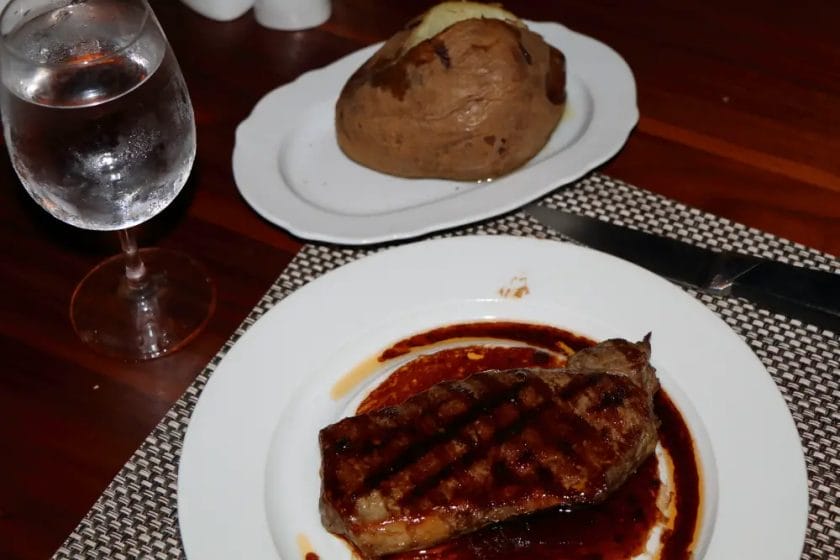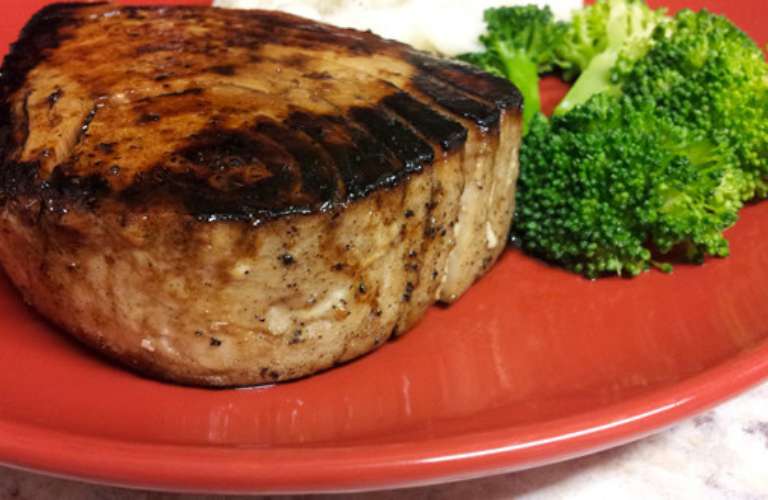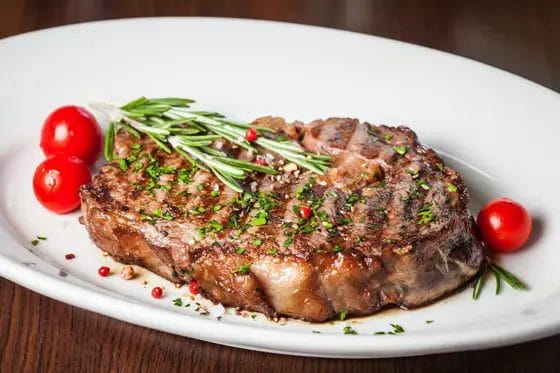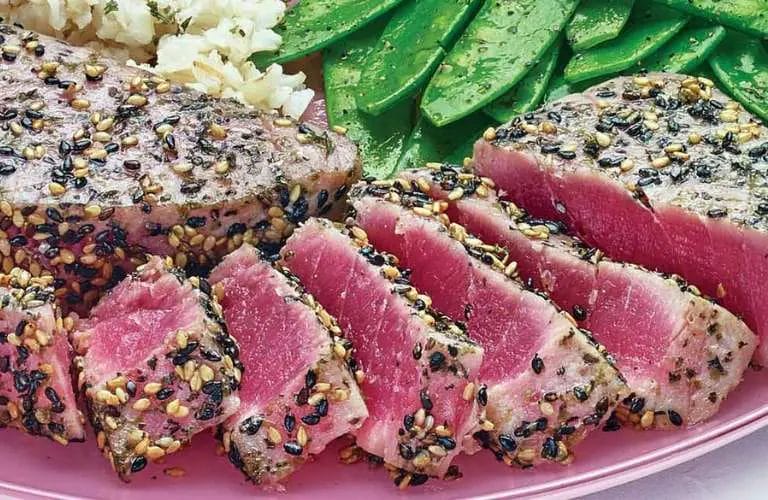Sea steak, also known as fish steak, is a delectable culinary delight that brings the taste of the ocean to your plate. Made from thick cross-sections of various types of fish, such as tuna, salmon, or swordfish, sea steak offers a tender and flavorful experience for seafood lovers.
Whether grilled, pan-seared, or oven-baked, this versatile dish can be enjoyed with a wide range of seasonings and sides. With its rich omega-3 fatty acids and protein content, sea steak is a healthy and mouthwatering option for seafood enthusiasts.

The Delightful Sea Steak: A Fresh Take on Seafood
Seafood has always been a favorite among food enthusiasts, and its sheer variety is a testament to its popularity. From succulent shrimp to tender fish fillets, there is something for everyone.
However, if you are looking for a unique seafood experience that will leave your taste buds craving for more, then the delightful sea steak is the perfect choice.
Sea steak is a term used to describe a thick cut of fish that closely resembles a traditional beef steak. It offers a tantalizing combination of flavors and textures that elevates your seafood dining experience to a whole new level.
Whether you are a seafood lover or a steak connoisseur, this culinary masterpiece is sure to impress.
1. The Perfect Cut
The first key element of a sea steak is the perfect cut. It should be thick, similar to a beef steak, allowing for a juicy and tender texture. Popular fish choices for sea steak include tuna, swordfish, and salmon.
These fish have a firm flesh that holds up well to grilling or searing, resulting in a delightful mouthfeel.
When selecting the ideal fish for your sea steak, look for vibrant colors, firm texture, and a fresh oceanic aroma. This ensures that you are getting the best quality fish that will not only taste exceptional but also provide maximum nutritional benefits.
2. Seasoning and Marination
Just like a beef steak, a sea steak can be enhanced with the right combination of seasonings and marination. This step is crucial in bringing out the flavors of the fish and creating a harmonious blend of tastes.
Common seasonings for sea steak include a mix of herbs like thyme, rosemary, and oregano, along with a sprinkle of sea salt and freshly ground black pepper. For an added kick, you can also incorporate spices like smoked paprika or cayenne pepper.
Marination helps to infuse the flavors into the fish and ensures a tender and juicy result. A simple marinade of olive oil, lemon juice, garlic, and a splash of soy sauce can work wonders. Allow the sea steak to marinate for at least 30 minutes to an hour, allowing the flavors to penetrate the fish.
3. Cooking Techniques
When it comes to cooking sea steak, there are various techniques that can be employed to achieve the desired results. Grilling, pan-searing, or broiling are popular methods that bring out the unique flavors and textures of the fish.
If you prefer a smoky charred flavor, grilling is the way to go. Preheat your grill to a medium-high temperature and brush the sea steak with oil to prevent sticking. Cook the fish for a few minutes on each side until it reaches the desired level of doneness.
Alternatively, pan-searing can create a crispy exterior while maintaining a moist interior. Heat a skillet over medium-high heat, add a drizzle of oil, and sear the sea steak for a few minutes on each side. This method provides a beautiful caramelization and locks in the flavors.
4. Serving Suggestions
The final step is the presentation and serving of the sea steak. This dish pairs well with a variety of sides and sauces, allowing you to get creative with your culinary creations.
For a refreshing accompaniment, serve the sea steak over a bed of mixed greens tossed in a citrus vinaigrette. The crispness of the greens balances out the richness of the fish, creating a delightful combination.
If you prefer a heartier option, serve the sea steak alongside roasted potatoes and grilled asparagus. This combination adds depth and texture to the dish, making it a satisfying meal for any occasion.

Exploring Sea Steak: A Unique Twist on Traditional Cuts
When it comes to enjoying a delicious steak, most people envision a juicy piece of beef cooked to perfection. However, there is a fascinating twist to this traditional favorite – sea steak. Sea steak refers to various types of seafood that offer a similar taste and texture to beef steak.
In this section, we will delve into the world of sea steak, exploring its origin, different varieties, and the best ways to prepare and enjoy it.
1. Sea Steak: A Brief History
Sea steak is not a new concept and has been a part of culinary traditions in coastal areas for centuries. The idea of using seafood as a substitute for beef originated from the need to incorporate locally available ingredients into dishes.
Fishermen and coastal communities began experimenting with different techniques to prepare seafood that resembled the tenderness and flavor of beef steak.
Over time, sea steak gained popularity not only for its unique taste but also for its nutritional benefits. Seafood, such as tuna, salmon, swordfish, and halibut, are rich in omega-3 fatty acids, essential minerals, and vitamins. This made sea steak a healthier alternative to traditional beef steak.
2. Varieties of Sea Steak
Sea steak encompasses a wide range of seafood options, each offering a distinct flavor profile and texture. Let’s explore some popular varieties:
- Tuna: Tuna is often referred to as the “steak of the sea” due to its meaty texture and robust flavor. Yellowfin and bluefin tuna are commonly used for sea steak preparations.
- Salmon: Rich in omega-3 fatty acids, salmon is a popular choice for sea steak. Its buttery texture and delicate flavor make it a versatile option for various cooking methods.
- Swordfish: With its firm texture and mild taste, swordfish is another excellent choice for sea steak. It holds up well to grilling and pan-searing, giving it a satisfying meat-like consistency.
- Halibut: Halibut offers a tender and flaky texture, making it an ideal option for sea steak. Its mild flavor allows for a wide range of seasoning and cooking styles.
- Mahi-Mahi: Also known as dolphinfish, mahi-mahi has a firm texture and a slightly sweet flavor. It can be grilled, seared, or broiled to perfection.
3. Cooking and Serving Sea Steak
Preparing sea steak requires some culinary finesse to bring out the best flavors and textures. Here are a few popular cooking methods:
- Grilling: Grilling sea steak enhances its smoky flavors and creates beautiful grill marks. Marinating the seafood beforehand can add an extra layer of flavor.
- Pan-Searing: Pan-searing sea steak on high heat gives it a caramelized exterior while preserving its moistness. This method works well for tuna and swordfish.
- Baking: Baking sea steak in the oven allows for gentle and even cooking. This method is suitable for delicate varieties like salmon and halibut.
- Ceviche: Ceviche is a popular method of preparing sea steak, especially with raw fish. The seafood is marinated in citrus juice, which effectively “cooks” the fish without heat.
When it comes to serving sea steak, you can get creative with various accompaniments and sauces. Some popular options include pairing it with a tangy citrus salsa, a creamy avocado sauce, or a classic herb butter.
Additionally, you can serve sea steak alongside roasted vegetables, a fresh salad, or a side of rice or pasta.
Sea Steak Recipes: Unleashing the Flavor of the Ocean
Seafood is a culinary delight that brings the freshness of the ocean to our plates. One of the most versatile and flavorful seafood options is sea steak. Sea steak, also known as fish steak, offers a meaty texture and rich taste that rivals its land-based counterparts.
In this section, we will explore a variety of sea steak recipes that will help you unlock the full potential and flavor of the ocean.
1. Grilled Tuna Steak
Grilled tuna steak is a classic seafood dish that is both healthy and delicious. To prepare this delectable treat, start by marinating the tuna steak in a mixture of soy sauce, lemon juice, garlic, and olive oil. Let the steak soak up the flavors for at least 30 minutes.
Then, heat your grill to high heat and cook each side of the steak for about 3-4 minutes, or until desired doneness. Serve the grilled tuna steak with a side of roasted vegetables or a fresh salad for a satisfying meal.
2. Lemon Herb Salmon Steak
Salmon is another popular choice when it comes to sea steak. For a burst of fresh flavors, try making a lemon herb salmon steak. Begin by seasoning your salmon steak with salt, pepper, and a squeeze of lemon juice.
Then, prepare a herb-infused butter mixture by combining melted butter, minced garlic, fresh dill, and chopped parsley. Spread the herb butter over the salmon steak and bake it in the oven at 400°F (200°C) for approximately 15-20 minutes, or until the fish is cooked through and flakes easily.
Serve the lemon herb salmon steak with a side of steamed vegetables and rice for a complete meal.
3. Seared Swordfish Steak
Swordfish steak is a meaty and flavorful option that lends itself well to searing. To create a delicious seared swordfish steak, season the steak with salt, pepper, and a sprinkle of paprika. Heat a skillet over medium-high heat and add a drizzle of olive oil.
Sear the swordfish steak for about 3-4 minutes on each side, or until it develops a golden crust. Finish cooking the steak in a preheated oven at 400°F (200°C) for approximately 8-10 minutes, or until the fish is cooked to your desired level of doneness.
Serve the seared swordfish steak with a squeeze of lemon juice and a side of roasted potatoes for a hearty meal.
4. Teriyaki Mahi-Mahi Steak
Mahi-Mahi is a firm and flavorful fish that is perfect for creating a tasty teriyaki steak. To make a teriyaki mahi-mahi steak, start by marinating the fish in a mixture of soy sauce, ginger, garlic, brown sugar, and sesame oil for at least 30 minutes.
Heat a grill or grill pan over medium heat and cook each side of the steak for about 4-5 minutes, or until it is cooked through. Baste the steak with the remaining teriyaki marinade while cooking to infuse it with extra flavor.
Serve the teriyaki mahi-mahi steak with a side of steamed rice and stir-fried vegetables for a delightful Asian-inspired meal.
5. Cajun-Style Halibut Steak
For those who enjoy a bit of spice, Cajun-style halibut steak is the perfect choice. To create this flavorful dish, rub the halibut steak with a Cajun seasoning blend, which typically includes ingredients like paprika, cayenne pepper, garlic powder, and onion powder.
Heat a skillet over medium-high heat and add a drizzle of vegetable oil. Cook the halibut steak for about 4-5 minutes on each side, or until it is cooked through and flakes easily. Serve the Cajun-style halibut steak with a squeeze of lime juice and a side of creamy coleslaw for a taste of the bayou.

Benefits of Sea Steak: A Healthy and Sustainable Protein Option
Sea steak, a term used to describe various types of fish that can be cooked and served similar to traditional beef steak, offers numerous benefits as a healthy and sustainable protein option.
With increasing concerns about the environmental impact of land-based animal agriculture and the desire for healthier food choices, sea steak has gained popularity in recent years. In this section, we will explore the various benefits that sea steak brings to the table.
1. Nutritional Value
Sea steak is packed with essential nutrients that are beneficial for our health. It is an excellent source of high-quality protein, which is essential for building and repairing tissues, supporting muscle growth, and maintaining overall body function.
Sea steak is also rich in omega-3 fatty acids, particularly docosahexaenoic acid (DHA) and eicosapentaenoic acid (EPA), which are known to promote heart health, reduce inflammation, and support brain function.
Additionally, sea steak is a good source of vitamins such as vitamin D, vitamin B12, and vitamin A, as well as minerals like iron, zinc, and selenium. These nutrients play vital roles in maintaining a healthy immune system, supporting red blood cell production, and ensuring proper growth and development.
2. Low in Fat and Calories
Compared to traditional beef steak, sea steak is generally lower in fat and calories, making it a healthier choice for those looking to manage their weight or reduce their saturated fat intake.
The lean nature of sea steak combined with its high protein content makes it a satisfying option that can help curb hunger and promote satiety.
Furthermore, sea steak is also lower in cholesterol compared to beef steak, making it a suitable choice for individuals with specific dietary restrictions or concerns about their cardiovascular health.
3. Sustainability
One of the primary advantages of sea steak is its sustainability. As concerns over the environmental impact of traditional livestock farming continue to grow, seafood offers a more sustainable alternative.
Fish are a renewable resource, and when sourced responsibly, seafood production can have a lower carbon footprint compared to land-based animal agriculture.
In addition, many seafood species used for sea steak, such as salmon, tuna, and mackerel, are often wild-caught or farmed through responsible aquaculture practices. These methods aim to minimize the impact on marine ecosystems, protect biodiversity, and ensure the long-term viability of fish populations.
4. Versatility and Delicious Flavor
Sea steak offers a wide range of flavors and textures, making it a versatile ingredient in various culinary preparations. From pan-seared salmon to grilled tuna steaks, sea steak can be cooked to perfection and enjoyed with different herbs, seasonings, and sauces.
Its tender and succulent nature, combined with the natural umami flavor, provides a delightful dining experience. Sea steak can be a perfect substitute for beef in many recipes, providing a healthier protein option without compromising on taste.
Tips for Cooking Sea Steak: Perfecting the Art of Seafood Grilling
Grilling seafood is a delicious and healthy way to enjoy a meal, and one of the most popular choices is sea steak. Sea steak, also known as fish steak, is a thick cut of fish that can be cooked on the grill to perfection.
Whether you’re a seasoned grill master or a beginner, these tips will help you perfect the art of cooking sea steak.
1. Choose the Right Seafood
The first step in cooking a delicious sea steak is selecting the right seafood. Opt for fish that has a firm texture and mild flavor, such as tuna, swordfish, or salmon. Freshness is key, so ensure that the fish is sourced from a reputable supplier and has a clean, ocean-like smell.
2. Prep the Sea Steak
Before grilling, it’s important to properly prep the sea steak. Start by patting the fish dry with paper towels to remove any excess moisture. This will ensure a better sear and prevent sticking. Season the steak with salt, pepper, and any other desired spices or herbs, allowing the flavors to penetrate the fish.
3. Preheat the Grill
Preheating the grill is essential to achieve a perfect sear on the sea steak. Set the grill to medium-high heat and allow it to heat up for at least 10 minutes. This will ensure that the fish cooks evenly and develops those coveted grill marks.
4. Oil the Grill Grates
To prevent the sea steak from sticking to the grill grates, it’s important to oil them before cooking. Use a brush or a folded paper towel dipped in vegetable oil to lightly coat the grates. This will create a non-stick surface and help achieve those beautiful grill marks.
5. Cook with Care
When it comes to cooking sea steak, timing is crucial. Overcooking can result in dry and tough fish, while undercooking can lead to a raw and unpleasant texture. As a general rule, cook the fish for about 6-8 minutes per inch of thickness, flipping it halfway through.
Remember that fish continues to cook after it’s removed from the grill, so it’s better to slightly undercook it than to overcook.
Additionally, avoid constantly flipping the fish as this can cause it to break apart. Use a spatula or tongs to carefully flip the steak once, allowing it to develop a beautiful crust on each side.
6. Serve and Enjoy
Once the sea steak is cooked to perfection, remove it from the grill and let it rest for a few minutes. This allows the juices to redistribute, resulting in a moist and flavorful fish. Serve the sea steak with your favorite sides, such as grilled vegetables or a fresh salad, and enjoy a mouthwatering seafood feast.

FAQs
What is sea steak?
Sea steak is a term used to describe thick slices of meat from large fish like tuna or swordfish. The texture of sea steak is often compared to that of beef steak, hence the name. It is a popular choice for grilling or pan-searing and is known for its rich flavor and meaty texture.
Conclusion
In conclusion, sea steak is a unique and innovative culinary creation that brings the flavors of the ocean to your plate. With its tender texture and rich taste, it offers a delightful seafood experience for those who enjoy exploring new culinary adventures.
Whether served as the main entrée or incorporated into various dishes, sea steak allows seafood lovers to indulge in a delectable and satisfying meal. Its versatility in cooking methods and its ability to complement a wide range of ingredients make it a favorite choice among chefs and food enthusiasts.
So, if you’re looking to elevate your seafood dining experience, give sea steak a try! It’s a delicious and exciting way to savor the wonders of the sea.

